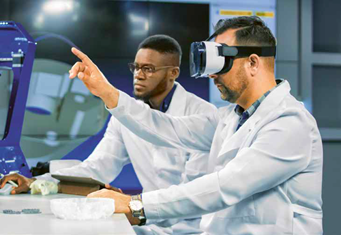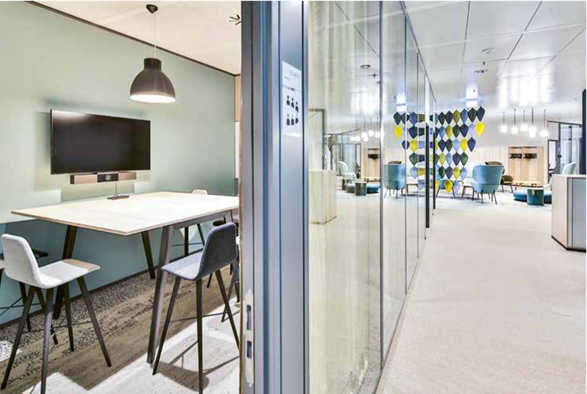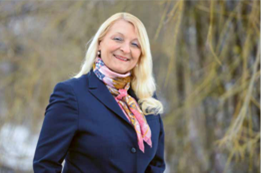S5. E15. 百靈佳殷格翰的工作新常態 THE WORK OF TOMORROW
在COVID-19疫情蔓延前, 人們的工作模式已經開始改變。百靈佳殷格翰也在積極打造工作的未來樣態:從VR虛擬實境訓練,到智慧辦公室,以及各種新穎的工作模式。
使用虛擬實境(VR)進行培育及訓練
複雜的藥品生產流程,對同仁們來說是極為獨特的挑戰。為了能正確地操縱複雜的機械,生產培訓與教育訓練的重要性與日愈增。百靈佳殷格翰也愈來愈頻繁地使用VR技術,來改善同仁的學習體驗並提高學習吸收率。例如:在德國殷格翰的 Solids Launch Factory正式營運之前,百靈佳殷格翰就以VR進行培訓做好進廠準備。 百靈佳殷格翰 Solids Launch Factory 以及VR試點計劃的負責人 Holger Holakovsky 表示:「我們已經研究VR教育訓練一段時間了;過去幾年中,教育訓練需要調整、宣導的內容很明顯的增加了,壓力也愈來愈大。」與傳統的教育訓練相比,VR 提供了關鍵優勢:每個人都可以按照自己的節奏學習,訓練內容能觸及各種感官,也能因此更記得學習內容。過去對數位化仍持保留態度的同仁們,也能以更有趣、積極的方式了解這個議題。



分享創意、進行合作的工作環境
辦公室的空間及設計概念,會直接影響辦公室同仁的快樂感受度。數位化是辦公室設計最重要的關鍵因素之一。百靈佳殷格翰德國卓越運營部門的主管 Hagen Mörbel 說:「我們希望為同仁們提供一個符合他們需求的工作環境,讓他們能更靈活、透明並且有效率的工作。」百靈佳殷格翰為不同地區的同仁所設計的優化工作流程,因國家與團隊而異。例如,在法國里昂和美國康乃狄克州 Ridgefield 的同仁,幾乎沒有個人單獨的辦公室。2020年底,百靈佳殷格翰建成一座新的智慧辦公大樓,可容納最多 1,000 名同仁在最先進的環境工作,這棟六層樓建築物,劃分為不同的區域,例如:聯合辦公室、多功能空間,以及無聲區,同仁們可根據各自的需求使用。辦公室也可按照不同的需求,調整、創造新的使用方式,讓大家可以一起工作,同仁彼此可以更常交流、合作,並提高工作滿意度。

在專業領域與前線勇者們並肩作戰
百靈佳殷格翰身為以研發為導向的生物製藥公司,與醫師們保持同樣的立場是非常重要的態度,這是打贏這場戰役的關鍵。 COVID-19 給整個世界帶來的新挑戰,廣至醫療保健領域,小至個人大至國家都受到不同程度的影響。為了更貼近醫師從業人員的需求,百靈佳殷格翰採取了新的做法;百靈佳殷格翰生物製藥業務 Andrea Wagner 解釋道:「在 COVID-19 之前,我每天都在路上奔波,拜訪客戶—通常一天會在醫院或診所與醫生們會見 7 到 10 次;在疫情期間,同事們大概只能拜訪過去一半數量的診所醫生,到醫院的比例及見面人次更低。」從 2020 年春天開始,Wagner 主要都是以視訊、電子郵件或電話等方式,與醫生或醫院負責人聯繫。她說,這個方法雖然行得通,但與真人實際碰面相比,這樣的聯繫比較缺少互動感。Wagner 補充道:「未來我們勢必會更頻繁的以數位化的工具與客戶聯繫,但重點仍然會放在與客戶之間的人際互動上。」
THE WORK OF TOMORROW
People’s work is changing – not just since the COVID-19 pandemic. Boehringer Ingelheim is also changing and actively shaping the future of work, from virtual reality trainings up to smart office buildings and new work models.
IN PRODUCTION: VIRTUAL REALITY IN TRAINING AND EDUCATION
The production of pharmaceuticals is very complex and presents unique challenges for employees. Training and education in production is becoming increasingly important in order for the complex machinery to be operated properly. To improve the learning experience and learning success, Boehringer Ingelheim is using virtual reality more and more frequently. For example, to prepare its employees for work at the new Solids Launch Factory in Ingelheim, the company conducted training sessions on virtual machines before the factory was put into operation. “We have been working on the topic of virtual reality in training and education for a while now. The pressure to adapt and advance content and learning formats has increased significantly in the last few years,” says Holger Holakovsky, who is Head of Production Solids Launch at Boehringer Ingelheim and responsible for one of the pilot projects in the field of virtual reality. Virtual reality offers key advantages over conventional training methods: Everyone can learn at their own pace, different senses are appealed to, and the lessons learned are retained better. And there is another positive side effect – employees who are wary of digitalization are introduced to the topic in an active and playful way.



ON-SITE: SPACE FOR SHARING IDEAS AND COLLABORATION
The concept and design of office spaces has direct impacts on the well-being of the employees working there. Digitalization is one of the most important drivers of room design. “We want to provide our employees with a work environment that fulfills their need for more flexible, more transparent, and more effective collaboration in a highly connected world,” says Hagen Mörbel, Head of Business Process Excellence in Germany. The redesigned work day at Boehringer Ingelheim can look different from country to country and team to team. For example, in Lyon, France, and Ridgefield, Connecticut, USA, there are hardly any individual offices anymore. There is also a lot going on at company headquarters in Ingelheim. In late 2020, Boehringer Ingelheim opened a new smart office building there, where up to 1,000 employees can work in a state-of-the-art environment. The new six-story building is divided into different zones where employees spend time depending on their tasks. For example, there are co-working zones, multi-use spaces, and quiet zones. Offices are going to be designed for creative and cooperative work at other locations as well. The goal is to allow a greater exchange of ideas and collaboration between colleagues and to increase employee satisfaction.

IN THE FIELD: CLOSE TO PARTNERS DESPITE COVID-19
For a research-driven biopharmaceutical company like Boehringer Ingelheim, it is very important to maintain a consistent dialogue with doctors. This is where the field force plays a key role. The COVID-19 pandemic presented the world with new challenges for personal contact in the healthcare sector – different countries were, and still are, affected to varying degrees. In order to remain close to doctors, the company took new routes. “Before COVID-19, I was on the road every day – the standard was seven to ten meetings with doctors in clinics. During the pandemic, many colleagues could only visit about half the doctors in medical practices, and the percentage was even lower at the hospitals,” explains Andrea Wagner, Pharmaceutical Representative at Boehringer Ingelheim. Since spring 2020, Wagner mainly speaks to doctors and hospital directors via video chat, e-mail, or by phone. It works well in many cases, she says, but it is less personal than meeting them at their offices. “We will certainly make more frequent use of the digital possibilities in the future, but the focus will still be on the personal contact with the customer,” says the pharmaceutical representative.

